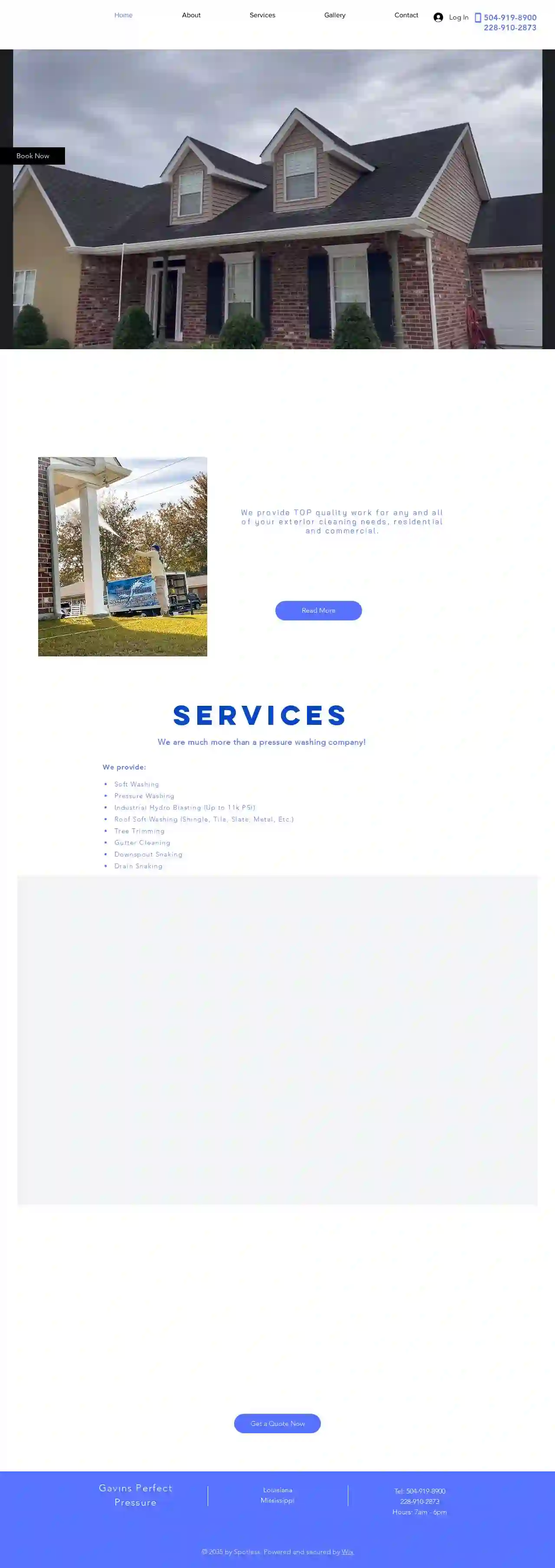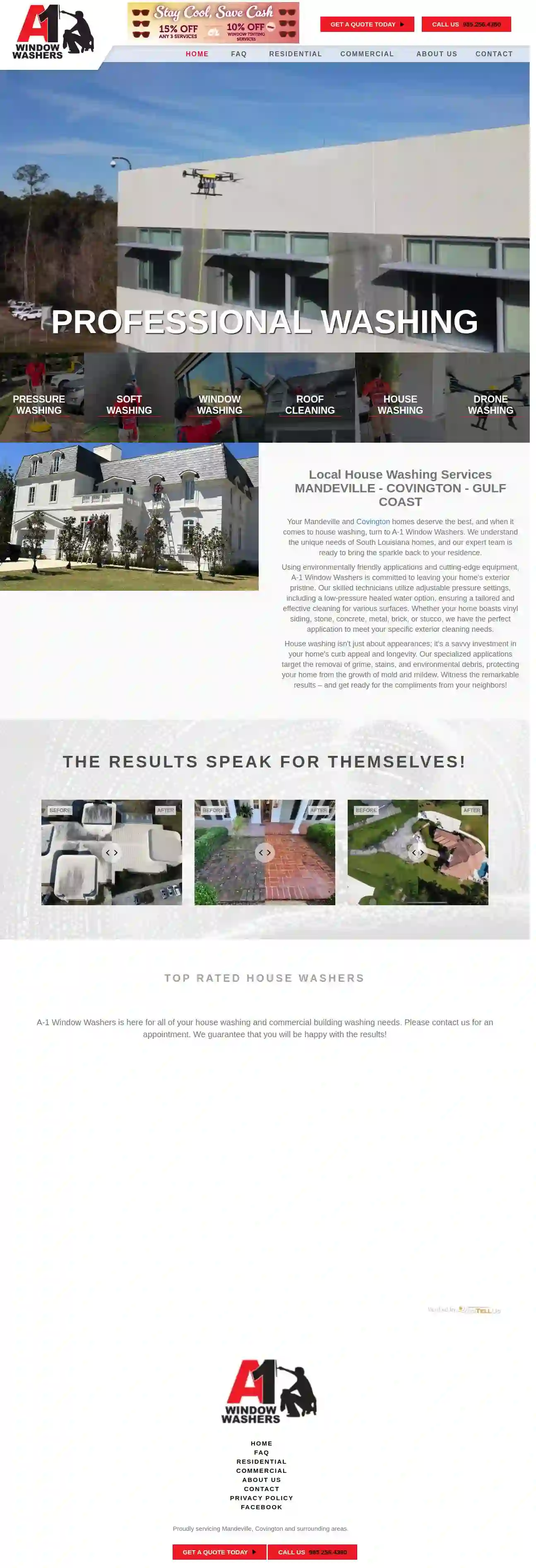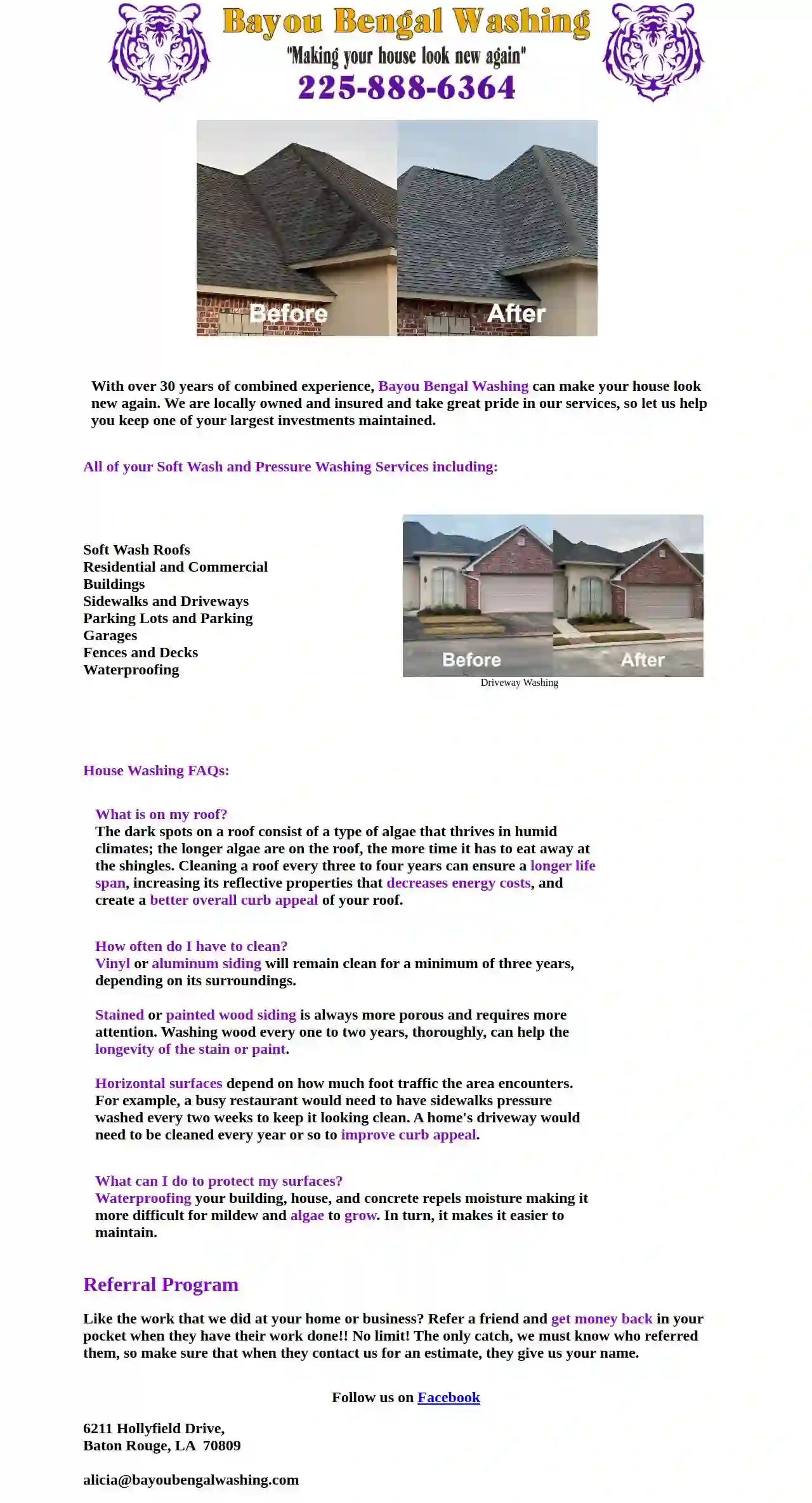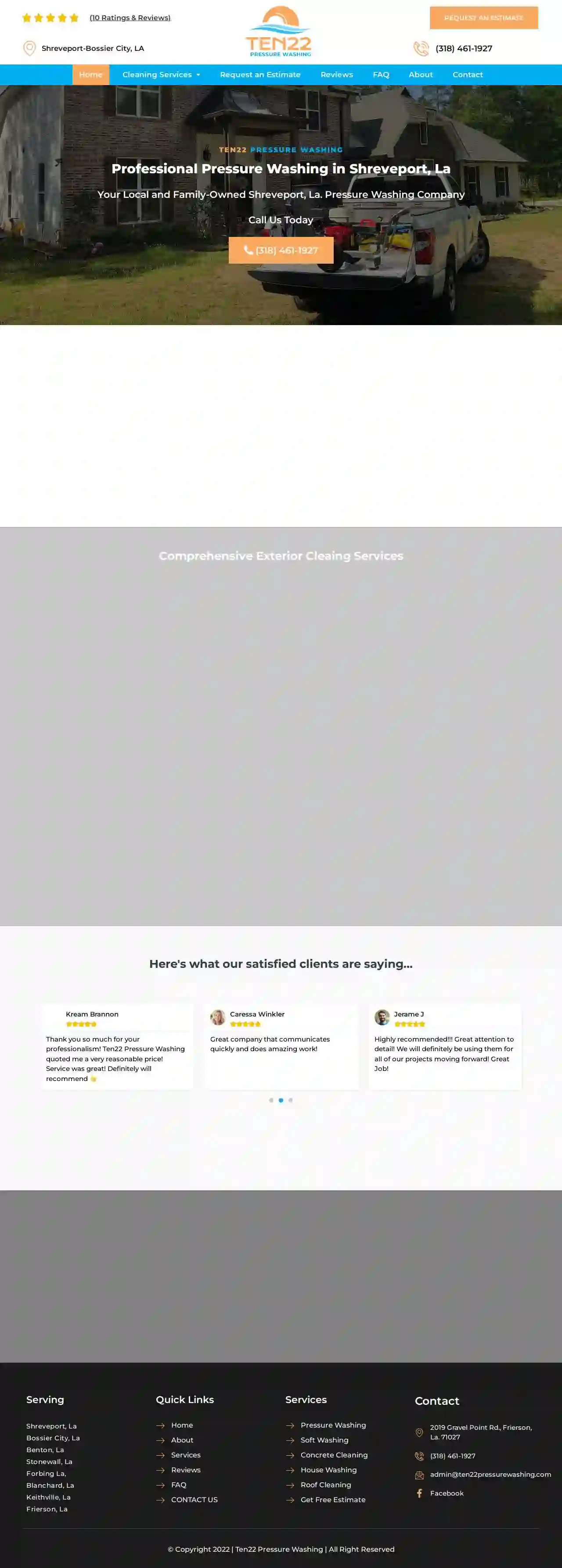Pressure Washing Lacombe
Best Pressure Washing in Lacombe
Receive up to 3 Deck and Fence Cleaning quotes for your project today! Compare profiles, reviews, accreditations, portfolio, etc... and choose the best deal.

JD's Pressure Washing Service
4.817 reviews12712 Found Stone Rd, N/A, Germantown, 20876, USJD's Pressure Washing Service is Germantown's leading pressure washing, interior, and exterior services company, dedicated to delivering exceptional cleaning services with unmatched professionalism and attention to detail. With state-of-the-art equipment and a team of skilled technicians, we transform your spaces, enhancing their beauty and extending their lifespan. Trust us to handle all your pressure washing needs, providing you with a pristine and inviting property every time.
- Services
- Why Us?
- Accreditations
- Our Team
- Testimonials
- Gallery
Get Quote
Top2Bottom Pressure Washing Service LLC
56 reviewsInsert address line 1 here, Insert address line 2 here, Insert street address here, Alexandria, Alexandria, LA, USTop 2 Bottom Pressure Washing is a locally owned and operated contractor offering Alexandria, LA and the surrounding communities with quality pressure and power washing services for your home or business. We are proud to offer quality exterior and fleet washing services for your home or business as well as new construction cleanup. Our courteous, knowledgeable technicians have the tools and training for all your roof, siding, driveway, and other exterior cleaning needs. We work directly with each client to understand your cleaning needs and budget. Whether you're looking for a small, one-time project, or full cleaning services on a recurring schedule, we can offer the services you need at prices you can afford.
- Services
- Why Us?
- Accreditations
- Our Team
- Gallery
Get Quote
RPM Pressure Washing LLC
529 reviewsDenham Springs, LA, 70726, USRPM Pressure Washing LLC is a professional power washing company in Denham Springs, LA. We offer respect, dedication, integrity, and a commitment to exceeding my customers' expectations. We are committed to delivering complete customer satisfaction for every service we provide.
- Services
- Why Us?
- Gallery
Get Quote
Gavin's Perfect Pressure
518 reviewsNew Orleans, LA, 123 Main St, 70119, USGavin's Perfect Pressure is a professional and reliable exterior cleaning service that offers top quality work for residential and commercial clients. They provide a range of services including soft washing, pressure washing, industrial hydro blasting, roof soft washing, tree trimming, gutter cleaning, downspout snaking, and drain snaking. Their team is dedicated to providing hassle-free estimates and ensuring customer satisfaction.
- Services
- Why Us?
- Accreditations
- Our Team
- Testimonials
- Gallery
Get Quote
A-1 Window Washers
5125 reviewsSlidell, LA, 123 Main St, 70458, USA-1 Window Washers is a full-service house washing company specializing in soft washing, pressure washing, window washing, sidewalk and driveway cleaning, and more. We take tremendous pride in our superior customer service and guaranteed professional results. Our trained house washing service technicians have the knowledge and equipment necessary to remove stubborn stains from homes and buildings. Our services are not limited to window washing. We use state-of-the-art equipment for pressure washing, roof cleaning, gutter cleaning and brightening, fence cleaning, awning cleaning, and much more. If it is an exterior surface, we have the expertise and equipment to clean it.
- Services
- Why Us?
- Accreditations
- Our Team
- Testimonials
- Gallery
Get Quote
Louisiana Jet Pressure Washing
510 reviews10000 block of Highway 171, Haughton, 71037, USLouisiana Jet Pressure Washing is a family-owned and operated business serving Haughton and Shreveport, LA, and surrounding areas. Owner Devin Nutt brings years of experience in the oil field, where he saw a growing need for pressure washing services. He decided to bring his expertise home to spend more time with his family while providing top-notch pressure washing services to the community. LA Jet Pressure Washing specializes in making your home or workspace look its best by efficiently cleaning its exterior. They offer a range of services, including roof washing, siding pressure washing, driveway pressure washing, exterior pressure washing, and paint removal. Devin is committed to providing excellent customer service, fair pricing, and high-quality work. He is licensed and insured, and his team uses commercial-grade equipment to ensure a thorough and effective clean. Whether you need a one-time cleaning or regular maintenance, LA Jet Pressure Washing can help you restore your property to its former glory.
- Services
- Why Us?
- Our Team
- Testimonials
- Gallery
Get Quote
Bayou Bengal Washing
52 reviews6211 Hollyfield Drive, Baton Rouge, 70809, USWith over 30 years of combined experience, Bayou Bengal Washing can make your house look new again. We are locally owned and insured and take great pride in our services, so let us help you keep one of your largest investments maintained. All of your Soft Wash and Pressure Washing Services including: Soft Wash Roofs Residential and Commercial Buildings Sidewalks and Driveways Parking Lots and Parking Garages Fences and Decks Waterproofing Driveway Washing Sidewalk Washing Driveway Washing Walkway Washing Patio Washing Patio Washing House Washing FAQs: What is on my roof? The dark spots on a roof consist of a type of algae that thrives in humid climates; the longer algae are on the roof, the more time it has to eat away at the shingles. Cleaning a roof every three to four years can ensure a longer life span, increasing its reflective properties that decreases energy costs, and create a better overall curb appeal of your roof. How often do I have to clean? Vinyl or aluminum siding will remain clean for a minimum of three years, depending on its surroundings. Stained or painted wood siding is always more porous and requires more attention. Washing wood every one to two years, thoroughly, can help the longevity of the stain or paint. Horizontal surfaces depend on how much foot traffic the area encounters. For example, a busy restaurant would need to have sidewalks pressure washed every two weeks to keep it looking clean. A home's driveway would need to be cleaned every year or so to improve curb appeal. What can I do to protect my surfaces? Waterproofing your building, house, and concrete repels moisture making it more difficult for mildew and algae to grow. In turn, it makes it easier to maintain. Referral Program Like the work that we did at your home or business? Refer a friend and get money back in your pocket when they have their work done!! No limit! The only catch, we must know who referred them, so make sure that when they contact us for an estimate, they give us your name. Follow us on Facebook 6211 Hollyfield Drive, Baton Rouge, LA 70809 [email protected]
- Services
- Why Us?
- Our Team
- Gallery
Get Quote
Ten22 Pressure Washing
512 reviews2019 Gravel Point Rd., Frierson, 71027, USTEN22 Pressure Washing is a locally and family-owned pressure washing company serving Shreveport, La, Bossier City, La, Benton, La, Stonewall, La, Forbing La, Blanchard, La, Keithville, La, and Frierson, La. We offer a full line of commercial and residential services, including pressure washing, soft washing, concrete cleaning, house washing, and roof cleaning. Our team is dedicated to providing safe and effective cleaning methods, with same-day quotes and free estimates. We pride ourselves on our attention to detail and commitment to customer satisfaction.
- Services
- Why Us?
- Testimonials
- Gallery
Get Quote
Cleanscapes Pressure Washing & Power Washing
56 reviewsBossier City, LA, USAt Cleanscapes PW, we pride ourselves on providing top-notch pressure washing and power washing services to our customers. With years of experience and a team of highly trained professionals, we can tackle any cleaning job, from residential to commercial properties. Our services include pressure washing, power washing, house washing, roof cleaning, window cleaning, concrete cleaning, gutter cleaning, fence cleaning, fence staining, and parking lot striping. We serve multiple locations in Louisiana, including Bossier City, Eastwood, Benton, Haughton, Blanchard, Stonewall, Greenwood, and Keithville. Contact us today to get a free quote and experience the Cleanscapes difference!
- Services
- Why Us?
- Our Team
- Testimonials
- Gallery
Get Quote
Rhino Blast Exterior Cleaning, LLC
4.944 reviewsCovington, 70433, USRhino Blast Exterior Cleaning is a locally owned and family operated exterior cleaning company serving residential, commercial, and multi-unit customers throughout Southeast Louisiana and surrounding areas. We offer a variety of exterior cleaning packages designed to meet our customers' needs, budget, and timelines. We are committed to providing our customers with personalized experiences through superior customer service and excellent quality work. Why Choose the Rhino: Personalized Experiences, Professionalism, Superior customer service, Free estimates, Prompt scheduling, Attention to detail, Experienced technicians, State of the art cleaning equipment, Uniformed technicians.
- Services
- Why Us?
- Gallery
Get Quote
Over 60,241+ Janitorial Companies on our directory
Our cleaning services operate in Lacombe and surroundings!
CleaningMatch has curated and vetted the Best Janitorial Services in Lacombe. Find the most reliable contractor today.
Frequently Asked Questions About Pressure Washing
- Wood Siding: High-pressure washing can damage wood fibers, leading to splintering or etching. Soft washing is the recommended method for cleaning wood siding.
- Asphalt Shingles: High-pressure water can dislodge granules from asphalt shingles, reducing their lifespan. Soft washing is a gentler alternative for roof cleaning.
- Painted Surfaces: High pressure can strip paint from surfaces. Always test pressure washing on an inconspicuous area before cleaning painted surfaces.
- Windows and Screens: The force of pressure washing can break windows or damage delicate window screens. Traditional cleaning methods are better suited for windows and screens.
- Size of the Area: Larger areas generally cost more to pressure wash than smaller ones.
- Type of Surface: Different surfaces require different pressure levels and cleaning solutions, which can affect pricing.
- Condition of the Surface: Heavily soiled or stained surfaces may require more time and effort to clean, impacting cost.
- Accessibility: Difficult-to-reach areas may require specialized equipment and increase costs.
- Additional Services: Services like pre-treating stains, applying protective coatings, or mold removal may incur additional charges.
- Soft Washing: Soft washing is generally recommended for wood decks as it uses lower pressure and specialized cleaning solutions to safely remove dirt, mildew, and algae without causing damage.
- Lower Pressure Setting: If using a pressure washer on a wood deck, use a lower pressure setting (around 1500 PSI) and a wide-angle nozzle (25-40 degrees).
- Maintain Distance: Hold the nozzle at least 12 inches away from the deck surface to prevent etching or splintering.
- Professional Pressure Washing: If you're unsure about pressure washing your deck safely, hire a professional pressure washing company with experience in cleaning wood surfaces.
- Enhanced Curb Appeal: Pressure washing removes dirt, grime, and stains, instantly revitalizing the appearance of your property and boosting curb appeal.
- Improved Health and Safety: Pressure washing removes mold, mildew, algae, and other contaminants that can pose health risks and create slippery surfaces.
- Increased Property Value: A well-maintained exterior, achieved through regular pressure washing, can increase the value of your property.
- Preventative Maintenance: Pressure washing removes dirt and grime that can deteriorate surfaces over time, extending the lifespan of your driveway, deck, fence, and other exterior features.
- Preparation for Painting or Staining: Pressure washing is an essential step before painting or staining, as it provides a clean and receptive surface for the new coating to adhere to.
Is pressure washing safe for all surfaces?
Always consult with a professional pressure washing company to determine the appropriate cleaning method for your specific surfaces.
How much does pressure washing cost?
To get accurate pricing, request quotes from multiple pressure washing companies. Provide details about the size and type of surface, its condition, and any additional services you require.
Can pressure washing damage my deck?
By using the right cleaning method and precautions, you can effectively clean your wood deck without causing damage and prolong its lifespan.
What are the benefits of pressure washing?
Whether you're looking to improve your property's appearance, protect its value, or enhance health and safety, pressure washing is a valuable investment.
Is pressure washing safe for all surfaces?
- Wood Siding: High-pressure washing can damage wood fibers, leading to splintering or etching. Soft washing is the recommended method for cleaning wood siding.
- Asphalt Shingles: High-pressure water can dislodge granules from asphalt shingles, reducing their lifespan. Soft washing is a gentler alternative for roof cleaning.
- Painted Surfaces: High pressure can strip paint from surfaces. Always test pressure washing on an inconspicuous area before cleaning painted surfaces.
- Windows and Screens: The force of pressure washing can break windows or damage delicate window screens. Traditional cleaning methods are better suited for windows and screens.
Always consult with a professional pressure washing company to determine the appropriate cleaning method for your specific surfaces.
How much does pressure washing cost?
- Size of the Area: Larger areas generally cost more to pressure wash than smaller ones.
- Type of Surface: Different surfaces require different pressure levels and cleaning solutions, which can affect pricing.
- Condition of the Surface: Heavily soiled or stained surfaces may require more time and effort to clean, impacting cost.
- Accessibility: Difficult-to-reach areas may require specialized equipment and increase costs.
- Additional Services: Services like pre-treating stains, applying protective coatings, or mold removal may incur additional charges.
To get accurate pricing, request quotes from multiple pressure washing companies. Provide details about the size and type of surface, its condition, and any additional services you require.
Can pressure washing damage my deck?
- Soft Washing: Soft washing is generally recommended for wood decks as it uses lower pressure and specialized cleaning solutions to safely remove dirt, mildew, and algae without causing damage.
- Lower Pressure Setting: If using a pressure washer on a wood deck, use a lower pressure setting (around 1500 PSI) and a wide-angle nozzle (25-40 degrees).
- Maintain Distance: Hold the nozzle at least 12 inches away from the deck surface to prevent etching or splintering.
- Professional Pressure Washing: If you're unsure about pressure washing your deck safely, hire a professional pressure washing company with experience in cleaning wood surfaces.
By using the right cleaning method and precautions, you can effectively clean your wood deck without causing damage and prolong its lifespan.
What are the benefits of pressure washing?
- Enhanced Curb Appeal: Pressure washing removes dirt, grime, and stains, instantly revitalizing the appearance of your property and boosting curb appeal.
- Improved Health and Safety: Pressure washing removes mold, mildew, algae, and other contaminants that can pose health risks and create slippery surfaces.
- Increased Property Value: A well-maintained exterior, achieved through regular pressure washing, can increase the value of your property.
- Preventative Maintenance: Pressure washing removes dirt and grime that can deteriorate surfaces over time, extending the lifespan of your driveway, deck, fence, and other exterior features.
- Preparation for Painting or Staining: Pressure washing is an essential step before painting or staining, as it provides a clean and receptive surface for the new coating to adhere to.
Whether you're looking to improve your property's appearance, protect its value, or enhance health and safety, pressure washing is a valuable investment.